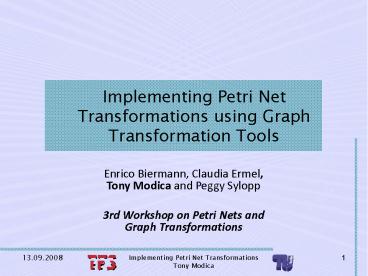Implementing Petri Net Transformations - PowerPoint PPT Presentation
Title:
Implementing Petri Net Transformations
Description:
Implementing Petri Net Transformations using Graph Transformation Tools Enrico Biermann, Claudia Ermel, Tony Modica and Peggy Sylopp 3rd Workshop on Petri Nets and – PowerPoint PPT presentation
Number of Views:315
Avg rating:3.0/5.0
Title: Implementing Petri Net Transformations
1
Implementing Petri Net Transformations using
Graph Transformation Tools
- Enrico Biermann, Claudia Ermel,Tony Modica and
Peggy Sylopp - 3rd Workshop on Petri Nets and Graph
Transformations
2
Overview
Petri nets to typed attributed graphs
3
Category of Petri nets
- Common frameworkHigh-level Replacement Systems
(DPO) - category PTSys
- Petri systems PS (PN, M)
- algebraic with monoids
- net PN (P,T, pre,postT?P )
- (similar to graphs with hyper edges)
- marking M?P
- morphisms (fP,fT)PS1?PS2
- place mapping fPP1?P2
- transition mapping fTT1?T2
- with some structural conditions
?
?
4
Properties of Petri net morphisms
- conditions for (fP,fT)PS1?PS2
- preservation of transitions pre andpost domain
(environment) - preservation of markings per token
- Morphism called strict if (and injective)
- in general not
- conditions ensure preservation of firing behavior
5
Petri net transformation rules
- strict rule morphisms l, r
- rule is applicable if l and m satisfy gluing
condition (ensuring existence of pushout
complement D) - Gluing Points are all LHS nodes in the image of
l(matched by the rule but not deleted) - Dangling Points are all LHS places that would
leave a dangling edge after deletion - Identification Points are all LHS nodes being
matched non-injectively - gluing condition (1) (2) m is strict on places
to be deleted - In short Dont delete places without their
adjacent transitions!And dont match those
places with less tokens! - we only consider injective matches for now
- (no transitions as DP because P/T-morphisms
preserve environments)
6
Simulating Petri net transformationwith graph
transformation
- rule application and match search
- obvious translation of P/T-systems and extension
to (injective) P/T-morphisms - problems because of P/T-morphism properties
straightforward translation of P/T-rules yields
graph rules with - too many applications (graph matches do not
preserve transition node environments) - less applications (graph matching of token
attribute is strict) - we want match calculation, so we need a proper
rule translation - (translation is not a functor, non-strict
P/T-morphisms do not have valid translations)
7
Problem 1 domain preservation
- graph morphisms are not restricted to preserve
transition environments - translated graph rule can have more applicable
matches than original Petri net rule - solution two negative application conditions
for each transition in LHS - forbid matching of transition if there are
unmatched places in its environment
8
Problem 2 token matching
- graph attributes can be matched on same values
only! - non-strict P/T-morphisms can not be directly
translated - introduce token variable for each place in LHS
that will not be deleted (i.e., has preimage in
K) - rule attributes assume values determined by match
- attribute condition to allow non-strict token
attribute matching for graph morphisms - (each xy equivalent to y NACs with less than y
tokens on respective place)
9
Tool implementation
- Eclipse Plug-In based on EMF (Eclipse Modeling
Framework) and GEF (Graphical Editor Framework) - RON - Reconfigurable Object Nets (variant of
Algebraic Higher-Order Nets) - editing of P/T-systems, rules, controlling
high-level net - uses AGG as graph transformation engine for match
search and rule application - converts Petri nets and rules to AGG graphs and
rules - reflects changes on translated graph back to
Petri net after rule application
10
Example Train loading
- trains that can be (un)loaded over a ramp on the
last wagon - each wagon can hold 3 pieces of load
- loads can be shifted to adjacent wagons
- if the loading wagon is full we can add an empty
one after it - we can remove an empty loading wagon, but only if
theres still another wagon
11
Example Train loading (formal)
- Petri net for train with 2 wagons
- places for counting free spaces instead of
capacities - firing of transitions for (un)loading and
shifting - rule for extending a train
- applicable on loading wagons carrying 3 cargo
units - rule for reducing a train
- applicable on loading wagons with 3 free spaces
- the next wagon is preserved
12
Future work and outlook
- extended translation for non-injective matches
(regarding arc weight sums) - theory for P/T-rules with non-strict morphisms to
change markings - formal proofs for ourextended translation
- correctness for a Petri net rule each result of
a translated possible application is equivalent
to translationof the applications result - completeness for a Petri net rule there are no
other applications for its translation than the
translated possible applications for itself
13
- Thank you!
14
Literature
- AGG AGG Homepage. http//tfs.cs.tu-berlin.de/agg
- BEHM07 E. Biermann, C. Ermel, F. Hermann, T.
Modica. A Visual Editor for Recon?gurable Object
Nets based on the ECLIPSE Graphical Editor
Framework. Proc. Workshop on Algorithms and Tools
for Petri Nets (AWPN07). 2007.http//tfs.cs.tu-b
erlin.de/roneditor - BM08 E. Biermann, T. Modica. Independence
Analysis of Firing and Rule-based Net
Transformations in Recon?gurable Object Nets.
Proc. Workshop on Graph Transformation and Visual
Modeling Techniques. (GT-VMT08). Vol. 10.
EC-EASST, 2008. - EHP08 H. Ehrig, K. Hoffmann, J. Padberg, C.
Ermel, U. Prange, E. Biermann, T. Modica. Petri
Net Transformations. In Petri Net Theory and
Applications. Pp. 116. I-Tech Education and
Publication, 2008.































